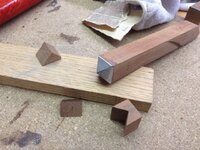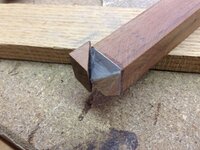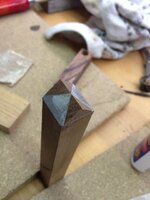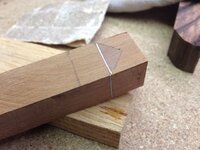Krash
Member
I've only turned and finished 2 pens and I am hooked. I dove in deep to start segmenting and my other post shows my practice blank.
Looking at the scallops around the site, I was wondering in my crazed mind how one could do a one-sided, single scallop in the center of a blank. So, off I went in my mind to experiment.
Using the same techniques that Mike shows and explains, I added another step to get just the bottom scallop row instead of the interlocking scallops I see all over.
In the first photo, I have cut the wedge like normal scallops. But instead of splicing the aluminum and gluing the wedge back on, I cut the same wedge cut on the next side over creating a pyramid. I then glue aluminum on the 4 faces, sanding back to square after each one. You could probably do the two facing ones at the same time. This photo shows the finished aluminum-faced pyramid.
The second shows the wood being glued back on and the third photo shows the facing sides glued and squared, ready for the original wedge to be glued back on.
The forth photo shows everything back together. It should produce just the bottom scallop portion of the interlocking scallops seen elsewhere.
The next thing I'm going to try is to reverse the angle of the second cut to try and get a sine wave around the pen. Stay tuned!
Let me know what you think and if you've seen this approach before.
Kelly
Looking at the scallops around the site, I was wondering in my crazed mind how one could do a one-sided, single scallop in the center of a blank. So, off I went in my mind to experiment.
Using the same techniques that Mike shows and explains, I added another step to get just the bottom scallop row instead of the interlocking scallops I see all over.
In the first photo, I have cut the wedge like normal scallops. But instead of splicing the aluminum and gluing the wedge back on, I cut the same wedge cut on the next side over creating a pyramid. I then glue aluminum on the 4 faces, sanding back to square after each one. You could probably do the two facing ones at the same time. This photo shows the finished aluminum-faced pyramid.
The second shows the wood being glued back on and the third photo shows the facing sides glued and squared, ready for the original wedge to be glued back on.
The forth photo shows everything back together. It should produce just the bottom scallop portion of the interlocking scallops seen elsewhere.
The next thing I'm going to try is to reverse the angle of the second cut to try and get a sine wave around the pen. Stay tuned!
Let me know what you think and if you've seen this approach before.
Kelly





